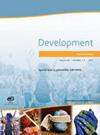这些报纸背后的人——吴燕、兰一玲和海蒂。
IF 3.7
2区 生物学
Q1 DEVELOPMENTAL BIOLOGY
引用次数: 0
摘要
脊椎动物的左右轴是在胚胎发育期间由一个被称为左右组织者的纤毛器官建立的。在斑马鱼中,这个器官被称为库普弗氏囊(KV)。发表在《发展》杂志上的一篇新论文表明,在KV发育的早期阶段发生的有丝分裂事件在塑造KV结构和功能方面发挥了重要作用。为了进一步了解这篇论文背后的故事,我们采访了第一作者吴燕和兰一玲,以及通讯作者Heidi Hehnly,她是美国雪城大学生物启发研究所的副教授兼副主任。本文章由计算机程序翻译,如有差异,请以英文原文为准。
The people behind the papers - Yan Wu, Yiling Lan and Heidi Hehnly.
The vertebrate left-right axis is established during embryonic development by a ciliated organ called the left-right organiser. In zebrafish, this organ is known as Kupffer's vesicle (KV). A new paper in Development demonstrates that mitotic events taking place in the KV at an early stage of its development play important roles in shaping KV architecture and function. To learn more about the story behind the paper, we caught up with first authors Yan Wu and Yiling Lan, and the corresponding author Heidi Hehnly, an Associate Professor and Associate Director of the BioInspired Institute at Syracuse University, USA.
求助全文
通过发布文献求助,成功后即可免费获取论文全文。
去求助
来源期刊

Development
生物-发育生物学
CiteScore
6.70
自引率
4.30%
发文量
433
审稿时长
3 months
期刊介绍:
Development’s scope covers all aspects of plant and animal development, including stem cell biology and regeneration. The single most important criterion for acceptance in Development is scientific excellence. Research papers (articles and reports) should therefore pose and test a significant hypothesis or address a significant question, and should provide novel perspectives that advance our understanding of development. We also encourage submission of papers that use computational methods or mathematical models to obtain significant new insights into developmental biology topics. Manuscripts that are descriptive in nature will be considered only when they lay important groundwork for a field and/or provide novel resources for understanding developmental processes of broad interest to the community.
Development includes a Techniques and Resources section for the publication of new methods, datasets, and other types of resources. Papers describing new techniques should include a proof-of-principle demonstration that the technique is valuable to the developmental biology community; they need not include in-depth follow-up analysis. The technique must be described in sufficient detail to be easily replicated by other investigators. Development will also consider protocol-type papers of exceptional interest to the community. We welcome submission of Resource papers, for example those reporting new databases, systems-level datasets, or genetic resources of major value to the developmental biology community. For all papers, the data or resource described must be made available to the community with minimal restrictions upon publication.
To aid navigability, Development has dedicated sections of the journal to stem cells & regeneration and to human development. The criteria for acceptance into these sections is identical to those outlined above. Authors and editors are encouraged to nominate appropriate manuscripts for inclusion in one of these sections.
 求助内容:
求助内容: 应助结果提醒方式:
应助结果提醒方式:


